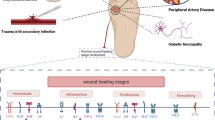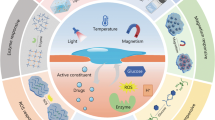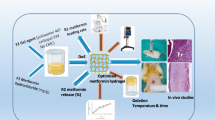Abstract
Wound healing could be categorized as a chronic disorder which needs a prompt and effective medication. Nowadays, vascular problems and wound-healing progression studies relay on the role of metformin; however, the exact mechanisms for its beneficial effects are still not completely understood. The aim of the present work was to study the potential of metformin hydrochloride, MET-HCL hydrogel in wound healing after topical administration. MET-HCL hydrogel was formulated using different hydrogel bases then characterised for its drug content and pH, homogeneity, viscosity, spreadability, and in vitro release. Furthermore, the wound-healing activity was evaluated in rats. Clinical study was also performed in patients showing lower limbs traumatic wounds and cutaneous ulcers. In addition, histopathology and immunohistochemical studies were also investigated. Results showed that MET-HCL hydrogels have a high drug content, and they are homogenous and spreadable with minimum sheer stress and showed null irritation. Furthermore, carbopol showed the optimum gel base for the highest MET-HCL release. Wound healing activity in rats showed a significant (p < 0.05) increase in the percentage wound contraction from the day-7 compared with plain hydrogel. Clinical study revealed a complete healing of traumatic wounds and cutaneous ulcers after 21 and 30 days, respectively. Moreover, histopathology investigation showed a complete restoration of connective tissue matrix and re-epithelization of the induced wound. In addition, immunohistochemistry showed a significant expression of transforming growth factor-β1 (TGF-β1). In conclusion, MET-HCL hydrogel is a promising formulation for topical treatment of wounds with effective and faster healing activity.




Similar content being viewed by others
References
Abbas SY, Basyouni WM, El-Bayouki KA, Abdel-Rahman RF (2016) Synthesis and evaluation of 1-substituted-biguanide derivatives as anti-diabetic agents for type II diabetes insulin resistant. Drug Res (Stuttg) 66:377–383. https://doi.org/10.1055/s-0042-107349
Abdelkader DH, Tambuwala MM, Mitchell CA, Osman MA, El-Gizawy SA, Faheem AM, El-Tanani M, McCarron PA (2018) Enhanced cutaneous wound healing in rats following topical delivery of insulin-loaded nanoparticles embedded in poly(vinyl alcohol)-borate hydrogels. Drug Deliv Transl Res 8:1053–1065. https://doi.org/10.1007/s13346-018-0554-0
Abdellatif AA, Abou-Taleb HA (2015) Optimization of nano-emulsion formulations for certain emollient effect. J Pharm Pharm Sci 4(12):1314–1328
Abdellatif AA, Abou-Taleb HA, El Ghany AA, Lutz I, Bouazzaoui A (2018) Targeting of somatostatin receptors expressed in blood cells using quantum dots coated with vapreotide. Saudi Pharm J 26(8):1162–1169
Abdellatif AA, Tawfeek HM (2015) Transfersomal Nanoparticles for Enhanced Transdermal Delivery of Clindamycin. AAPS PharmSciTech. https://doi.org/10.1208/s12249-015-0441-7
Abdellatif AA, Tawfeek HM (2016) Transfersomal nanoparticles for enhanced transdermal delivery of clindamycin. AAPS PharmSciTech 17:1067–1074. https://doi.org/10.1208/s12249-015-0441-7
Abdellatif AAH, Tawfeek HM (2016) Metformin loaded carbopol gel for lowering the intra-abdominal visceral fat. J Bioequiv Bioavailab. https://doi.org/10.4172/jbb.1000286
Abdellatif Ahmed A H, Abou-Taleb HA (2016) Transfersomal nanoparticles of keratolytic and antibacterial agents for enhanced transdermal delivery. J Nanotechnol Adv Mater 4:19–23
Aly UF (2012) Preparation and evaluation of novel topical gel preparations for wound healing in diabetics. Int J Pharm 4:76
Arayne MS, Sultana N, Zuberi MH, Siddiqui FA (2009) Spectrophotometric quantitation of metformin in bulk drug and pharmaceutical formulations using multivariate technique. Indian J Pharm Sci 71:331–335. https://doi.org/10.4103/0250-474X.56022
Boateng JS, Matthews KH, Stevens HN, Eccleston GM (2008) Wound healing dressings and drug delivery systems: a review. J Pharm Sci 97:2892–2923. https://doi.org/10.1002/jps.21210
Bodeker GC, Ryan TJ, Ong CK (1999) Traditional approaches to wound healing. Clin Dermatol 17:93–98
Bryan J (2004) Moist wound healing: a concept that changed our practice. J Wound Care 13:227–228
Choi J, Park YG, Yun MS, Seol JW (2018) Effect of herbal mixture composed of Alchemilla vulgaris and Mimosa on wound healing process. Biomed Pharmacother 106:326–332. https://doi.org/10.1016/j.biopha.2018.06.141
Collier CA, Bruce CR, Smith AC, Lopaschuk G, Dyck DJ (2006) Metformin counters the insulin-induced suppression of fatty acid oxidation and stimulation of triacylglycerol storage in rodent skeletal muscle. Am J Physiol Endocrinol Metab 291:E182–E189. https://doi.org/10.1152/ajpendo.00272.2005
Dallaglio K, Bruno A, Cantelmo AR, Esposito AI, Ruggiero L, Orecchioni S, Calleri A, Bertolini F, Pfeffer U, Noonan DM, Albini A (2014) Paradoxic effects of metformin on endothelial cells and angiogenesis. Carcinogenesis 35:1055–1066. https://doi.org/10.1093/carcin/bgu001
El Gazaerly H, Elbardisey DM, Eltokhy HM, Teaama DJ (2013) Effect of transforming growth factor Beta 1 on wound healing in induced diabetic rats. Int J Health Sci 7:160
El-Badry M, Fetih G, Fathalla D, Shakeel FJ (2015) Transdermal delivery of meloxicam using niosomal hydrogels: in vitro and pharmacodynamic evaluation. Pharm Dev Technol 20:820–826
El-Ridy MS, Yehia SA, Elsayed I, Younis MM, Abdel-Rahman FR, El-Gamil MA (2018) Metformin hydrochloride and wound healing: from nanoformulation to pharmacological evaluation. J Liposome Res. https://doi.org/10.1080/08982104.2018.1556291
Fung CS, Wan EY, Wong CK, Jiao F, Chan AK (2015) Effect of metformin monotherapy on cardiovascular diseases and mortality: a retrospective cohort study on Chinese type 2 diabetes mellitus patients. Cardiovasc Diabetol 14:137. https://doi.org/10.1186/s12933-015-0304-2
Han X, Tao Y, Deng Y, Yu J, Sun Y, Jiang G (2017) Metformin accelerates wound healing in type 2 diabetic db/db mice. Mol Med Rep 16:8691–8698. https://doi.org/10.3892/mmr.2017.7707
Jin SG, Kim KS, Kim DW, Kim DS, Seo YG, Go TG, Youn YS, Kim JO, Yong CS, Choi HG (2016) Development of a novel sodium fusidate-loaded triple polymer hydrogel wound dressing: mechanical properties and effects on wound repair. Int J Pharm 497:114–122. https://doi.org/10.1016/j.ijpharm.2015.12.007
Khan AW, Kotta S, Ansari SH, Sharma RK, Kumar A, Ali J (2013) Formulation development, optimization and evaluation of aloe vera gel for wound healing. Pharmacogn Mag 9:S6–S10. https://doi.org/10.4103/0973-1296.117849
Kucharzewski M, Rojczyk E, Wilemska-Kucharzewska K, Wilk R, Hudecki J, Los MJ (2019) Novel trends in application of stem cells in skin wound healing. Eur J Pharmacol 843:307–315. https://doi.org/10.1016/j.ejphar.2018.12.012
Kumari S, Harjai K, Chhibber S (2010) Topical treatment of Klebsiella pneumoniae B5055 induced burn wound infection in mice using natural products. J Infect Dev Ctries 4:367–377
Lee C-H, Hsieh M-J, Chang S-H, Lin Y-H, Liu S-J, Lin T-Y, Hung K-C, Pang J-HS, Juang J-H (2014) Enhancement of diabetic wound repair using biodegradable nanofibrous metformin-eluting membranes: in vitro and in vivo. ACS Appl Mater Interfaces 6:3979–3986. https://doi.org/10.1021/am405329g
Liberman HA, Rieger MM, Banker GS (1989) Pharmaceutical dosage form, disperse systems. J Pharm Sci 79:856
Liu Y, Tang G, Zhang Z, Wang Y, Yang GY (2014) Metformin promotes focal angiogenesis and neurogenesis in mice following middle cerebral artery occlusion. Neurosci Lett 579:46–51. https://doi.org/10.1016/j.neulet.2014.07.006
Martinez-Gomez F, Guerrero J, Matsuhiro B, Pavez J (2017) In vitro release of metformin hydrochloride from sodium alginate/polyvinyl alcohol hydrogels. Carbohydr Polym 155:182–191. https://doi.org/10.1016/j.carbpol.2016.08.079
Moura LI, Dias AM, Carvalho E, de Sousa HC (2013) Recent advances on the development of wound dressings for diabetic foot ulcer treatment—a review. Acta Biomater 9:7093–7114. https://doi.org/10.1016/j.actbio.2013.03.033
Ochoa-Gonzalez F, Cervantes-Villagrana AR, Fernandez-Ruiz JC, Nava-Ramirez HS, Hernandez-Correa AC, Enciso-Moreno JA, Castaneda-Delgado JE (2016) Metformin induces cell cycle arrest, reduced proliferation, wound healing impairment in vivo and is associated to clinical outcomes in diabetic foot ulcer patients. PLoS One 11:e0150900. https://doi.org/10.1371/journal.pone.0150900
Ovais M, Ahmad I, Khalil AT, Mukherjee S, Javed R, Ayaz M, Raza A, Shinwari ZK (2018) Wound healing applications of biogenic colloidal silver and gold nanoparticles: recent trends and future prospects. Appl Microbiol Biotechnol 102:4305–4318. https://doi.org/10.1007/s00253-018-8939-z
Pereira RF, Barrias CC, Granja PL, Bartolo PJ (2013) Advanced biofabrication strategies for skin regeneration and repair. Nanomedicine (Lond) 8:603–621. https://doi.org/10.2217/nnm.13.50
Qing L, Fu J, Wu P, Zhou Z, Yu F, Tang J (2019) Metformin induces the M2 macrophage polarization to accelerate the wound healing via regulating AMPK/mTOR/NLRP3 inflammasome singling pathway. Am J Transl Res 11:655–668
Remmele W, Stegner HE (1987) Recommendation for uniform definition of an immunoreactive score (IRS) for immunohistochemical estrogen receptor detection (ER-ICA) in breast cancer tissue. Pathologe 8:138–140
Rezvanian M, Tan C-K (2016) Ng S-FJDd, pharmacy i. Simvastatin-loaded lyophilized wafers as a potential dressing for chronic wounds. 42:2055–2062
Salazar JJ, Ennis WJ, Koh TJ (2016) Diabetes medications: impact on inflammation and wound healing. J Diabetes Complications 30:746–752. https://doi.org/10.1016/j.jdiacomp.2015.12.017
Setter SM, Iltz JL, Thams J, Campbell RK (2003) Metformin hydrochloride in the treatment of type 2 diabetes mellitus: a clinical review with a focus on dual therapy. Clin Ther 25:2991–3026
Soliman GM, Fetih G, Abbas AM (2016) Thermosensitive bioadhesive gels for the vaginal delivery of sildenafil citrate: in vitro characterization and clinical evaluation in women using clomiphene citrate for induction of ovulation. Drug Dev Ind Pharm 43:399–408. https://doi.org/10.1080/03639045.2016.1254239
Sporn MB (1987) Some recent advances in the chemistry and biology of transforming growth factor-beta. J Cell Biol 105:1039–1045
Tayeb AH, Amini E, Ghasemi S, Tajvidi M (2018) Cellulose nanomaterials-binding properties and applications: a review. Molecules. https://doi.org/10.3390/molecules23102684
Vaiserman AM, Lushchak OV, Koliada AK (2016) Anti-aging pharmacology: promises and pitfalls. Ageing Res Rev 31:9–35. https://doi.org/10.1016/j.arr.2016.08.004
van der Plas MJ, Dambrot C, Dogterom-Ballering HC, Kruithof S, van Dissel JT, Nibbering PH (2010) Combinations of maggot excretions/secretions and antibiotics are effective against Staphylococcus aureus biofilms and the bacteria derived therefrom. J Antimicrob Chemother 65:917–923. https://doi.org/10.1093/jac/dkq042
Veves A, Ochoa-Gonzalez F, Cervantes-Villagrana AR, Fernandez-Ruiz JC, Nava-Ramirez HS, Hernandez-Correa AC, Enciso-Moreno JA, Castañeda-Delgado JE (2016) Metformin induces cell cycle arrest, reduced proliferation, wound healing impairment in vivo and is associated to clinical outcomes in diabetic foot ulcer patients. PLoS One. https://doi.org/10.1371/journal.pone.0150900
Wang Q, Qian Z, Liu B, Liu J, Zhang L, Xu J (2019) In vitro and in vivo evaluation of new PRP antibacterial moisturizing dressings for infectious wound repair. J Biomater Sci Polym Ed. https://doi.org/10.1080/09205063.2019.1582270
Zhao P, Sui BD, Liu N, Lv YJ, Zheng CX, Lu YB, Huang WT, Zhou CH, Chen J, Pang DL, Fei DD, Xuan K, Hu CH, Jin Y (2017) Anti-aging pharmacology in cutaneous wound healing: effects of metformin, resveratrol, and rapamycin by local application. Aging Cell 16:1083–1093. https://doi.org/10.1111/acel.12635
Funding
There are no funding resources.
Author information
Authors and Affiliations
Corresponding authors
Ethics declarations
Conflict of interest
The authors declare that they have no conflicts of interest.
Additional information
Publisher's Note
Springer Nature remains neutral with regard to jurisdictional claims in published maps and institutional affiliations.
Rights and permissions
About this article
Cite this article
Tawfeek, H.M., Abou-Taleb, D.A.E., Badary, D.M. et al. Pharmaceutical, clinical, and immunohistochemical studies of metformin hydrochloride topical hydrogel for wound healing application. Arch Dermatol Res 312, 113–121 (2020). https://doi.org/10.1007/s00403-019-01982-1
Received:
Revised:
Accepted:
Published:
Issue Date:
DOI: https://doi.org/10.1007/s00403-019-01982-1




